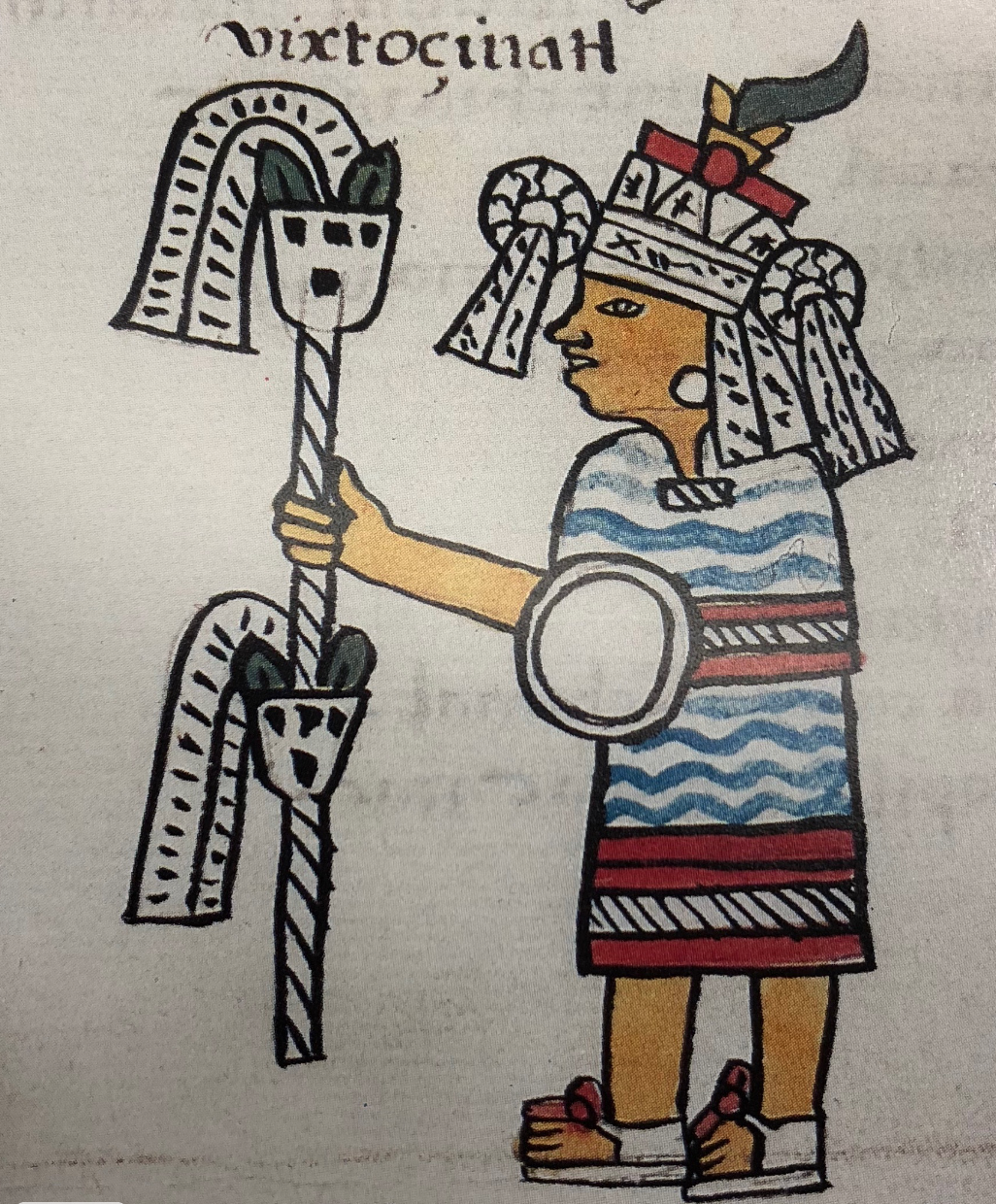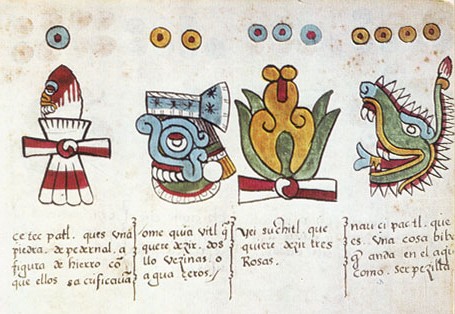|
Tlāloc
Tlaloc ( nci-IPA, Tlāloc, ˈtɬaːlok) is a deity in Aztec religion. The supreme god of the rain, Tlaloc is also a god of earthly fertility and of water. He was widely worshipped as a beneficent giver of life and sustenance, as well as feared for his ability to send hail, thunder, and lightning, and for being the lord of the powerful element of water. Tlaloc is also associated with caves, springs, and mountains, most specifically the sacred mountain where he was believed to reside. His animal forms include herons and water-dwelling creatures such as amphibians, snails, and some sea creatures, particularly shellfish. The Mexican marigold, ''Tagetes lucida'', known to the Aztecs as , was another important symbol of the god, and was burned as a ritual incense in native religious ceremonies. The cult of Tlaloc is one of the oldest and most universal in ancient Mexico. Although the name Tlaloc is specifically Aztec, worship of a storm god, associated with mountaintop shrines and wit ... [...More Info...] [...Related Items...] OR: [Wikipedia] [Google] [Baidu] |
Huixtocihuatl
In Aztec religion, Huixtocihuatl (or Uixtochihuatl, Uixtociuatl) was a fertility goddess who presided over salt and sea water, salt water. The Aztecs considered her to be the older sister of the rain gods, including Tlaloc. Much of the information known about Huixtocihuatl and how the Aztecs celebrated her comes from Bernardino de Sahagún, Bernardino de Sahagún's manuscripts. His Florentine Codex explains how Huixtocihuatl became the salt god. It records that Huixtocihuatl angered her younger brothers by mocking them, so they banished her to the salt beds. It was there where she discovered salt and how it was created. As described in the second book of the Florentine Codex, during Tecuilhuitontli, the seventh month of the Aztec calendar, there was a festival in honor of Huixtocihuatl. The festival culminated with the sacrifice of Huixtocihuatl's ixiptla, the embodiment of the deity in human form. Associations Huixtocihuatl was considered a provider god along with Chicomecōātl, ... [...More Info...] [...Related Items...] OR: [Wikipedia] [Google] [Baidu] |
Aztec
The Aztecs () were a Mesoamerican culture that flourished in central Mexico in the post-classic period from 1300 to 1521. The Aztec people included different Indigenous peoples of Mexico, ethnic groups of central Mexico, particularly those groups who spoke the Nahuatl, Nahuatl language and who dominated large parts of Mesoamerica from the 14th to the 16th centuries. Aztec culture was organized into city-states (''altepetl''), some of which joined to form alliances, political confederations, or empires. The Aztec Empire was a confederation of three city-states established in 1427: Tenochtitlan, city-state of the Mexica or Tenochca; Texcoco (altepetl), Texcoco; and Tlacopan, previously part of the Tepanec empire, whose dominant power was Azcapotzalco (altepetl), Azcapotzalco. Although the term Aztecs is often narrowly restricted to the Mexica of Tenochtitlan, it is also broadly used to refer to Nahuas, Nahua polities or peoples of central Pre-Columbian Mexico, Mexico in the preh ... [...More Info...] [...Related Items...] OR: [Wikipedia] [Google] [Baidu] |
Codex Magliabechiano
The Codex Magliabechiano is a pictorial Aztec codex created during the mid-16th century, in the early Spanish colonial period. It is representative of a set of codices known collectively as the ''Magliabechiano Group (others in the group include the Codex Tudela and the Codex Ixtlilxochitl).'' The Codex Magliabechiano is based on an earlier unknown codex, which is assumed to have been the prototype for the Magliabechiano Group. It is named after Antonio Magliabechi, a 17th-century Italian manuscript collector, and is held in the Biblioteca Nazionale Centrale, Florence, Italy. It was created on European paper, with drawings and Spanish language text on both sides of each page. The Codex Magliabechiano is primarily a religious document. Various deities, indigenous religious rites, costumes, and cosmological beliefs are depicted. Its 92 pages are almost a glossary of cosmological and religious elements. The 52-year cycle is depicted, as well as the 20 day-names of the '' tonalpohuall ... [...More Info...] [...Related Items...] OR: [Wikipedia] [Google] [Baidu] |
Tagetes Lucida
''Tagetes lucida'' is a perennial plant native to Mexico and Central America. It is used as a medicinal plant and as a culinary herb. The leaves have a tarragon-like scent, with hints of anise, and it has entered the nursery trade in North America as a tarragon substitute. Common names include sweetscented marigold, Mexican marigold, Mexican mint marigold, Mexican tarragon, sweet mace, Texas tarragon, pericón, yerbaniz, and hierbanís. Description ''Tagetes lucida'' grows tall and requires full sun to light shade. Depending on the variety or landrace, the plant may be fairly upright, while other forms appear bushy with many unbranching stems. The leaves are linear to oblong, about long, and shiny medium green, not blue-green as in French tarragon (''Artemisia dracunculus'' var. ''sativa''). In late summer it bears clusters of small golden yellow flower heads on the ends of the stems. The flower heads are about across and have 3–5 golden-yellow ray florets. The flow ... [...More Info...] [...Related Items...] OR: [Wikipedia] [Google] [Baidu] |
Mount Tlaloc
Mount Tlaloc (Spanish: Monte Tláloc, sometimes wrongly listed as ''Cerro el Mirador''; Nahuatl: ''Tlālōcatepētl'') is a mountain and archaeological site in central Mexico. It is located in the State of Mexico, in the municipalities of Ixtapaluca and Texcoco, close to the state border with Puebla. Formerly an active volcano, it has an official altitude of above sea level, thus being the 9th tallest mountain of Mexico. The mountain was considered by the Nahuan peoples, foremost among them the Aztecs, to be specially sacred to the raingod Tlaloc. In fact, the mountain was believed to be one of his primary earthly dwelling places, called Tlalocan. Attribution of this and other mountains to the sacred presence of rain deities predates the Aztec era by centuries, even millennia. At the summit there are still remains of a shrine where high ceremonies would have been carried out. The rites of Tlaloc were otherwise performed at his temples, most famously that occupying one half of ... [...More Info...] [...Related Items...] OR: [Wikipedia] [Google] [Baidu] |
Pre-Columbian Mexico
The pre-Columbian (or prehispanic) history of the territory now making up the country of Mexico is known through the work of archaeologists and epigraphers, and through the accounts of Spanish conquistadores, settlers and clergymen as well as the indigenous chroniclers of the immediate post-conquest period. Human presence in the Mexican region was once thought to date back 40,000 years based upon what were believed to be ancient human footprints discovered in the Valley of Mexico, but after further investigation using radioactive dating, it appears this is untrue. It is currently unclear whether 21,000-year-old campfire remains found in the Valley of Mexico are the earliest human remains in Mexico. Indigenous peoples of Mexico began to selectively breed maize plants around 8000 BC. Evidence shows a marked increase in pottery working by 2300 BC and the beginning of intensive corn farming between 1800 and 1500 BC. Between 1800 and 300 BC, complex cultures began to form. Many mat ... [...More Info...] [...Related Items...] OR: [Wikipedia] [Google] [Baidu] |
Storm God
A weather god or goddess, also frequently known as a storm god or goddess, is a deity in mythology associated with weather phenomena such as thunder, snow, lightning, rain, wind, storms, tornadoes, and hurricanes. Should they only be in charge of one feature of a storm, they will be called after that attribute, such as a rain god or a lightning/thunder god. This singular attribute might then be emphasized more than the generic, all-encompassing term "storm god", though with thunder/lightning gods, the two terms seem interchangeable. They feature commonly in polytheistic religions. Storm gods are most often conceived of as wielding thunder and/or lightning (some lightning gods' names actually mean "thunder", but since one cannot have thunder without lightning, they presumably wielded both). The ancients didn't seem to differentiate between the two, which is presumably why both the words "lightning bolt" and "thunderbolt" exist despite being synonyms. Of the examples currently liste ... [...More Info...] [...Related Items...] OR: [Wikipedia] [Google] [Baidu] |
Teotihuacan
Teotihuacan (Spanish language, Spanish: ''Teotihuacán'') (; ) is an ancient Mesoamerican city located in a sub-valley of the Valley of Mexico, which is located in the State of Mexico, northeast of modern-day Mexico City. Teotihuacan is known today as the site of many of the most architecturally significant Mesoamerican pyramids built in the pre-Columbian Americas, namely Pyramid of the Sun and Pyramid of the Moon. At its zenith, perhaps in the first half of the first millennium (1 CE to 500 CE), Teotihuacan was the largest city in the Americas, with a population estimated at 125,000 or more, making it at least the sixth-largest city in the world during its epoch. The city covered eight square miles (21 km2), and 80 to 90 percent of the total population of the valley resided in Teotihuacan. Apart from the pyramids, Teotihuacan is also anthropologically significant for its complex, multi-family residential compounds, the Avenue of the Dead, and its vibrant, well-prese ... [...More Info...] [...Related Items...] OR: [Wikipedia] [Google] [Baidu] |
Legends Of Dune
The ''Dune'' prequel series is a sequence of novel trilogies written by Brian Herbert and Kevin J. Anderson. Set in the ''Dune'' universe created by Frank Herbert, the novels take place in various time periods before and in between Herbert's original six novels, which began with 1965's ''Dune''. In 1997, Bantam Books made a $3 million deal with the authors for three ''Dune'' prequel novels, partially based upon notes left behind by Frank Herbert, that would come to be known as the ''Prelude to Dune'' trilogy. Starting with 1999's '' Dune: House Atreides'', the duo have published 13 ''Dune'' prequel novels to date. In 2011 ''Publishers Weekly'' called the series "a sprawling edifice that Frank Herbert’s son and Anderson have built on the foundation of the original ''Dune'' novels." Jon Michaud of ''The New Yorker'' wrote in 2013, "The conversion of ''Dune'' into a franchise, while pleasing readers and earning royalties for the Herbert estate, has gone a long way toward obscurin ... [...More Info...] [...Related Items...] OR: [Wikipedia] [Google] [Baidu] |
Aztec Religion
The Aztec religion is a monistic pantheism in which the Nahua concept of was construed as the supreme god , as well as a diverse pantheon of lesser gods and manifestations of nature. The popular religion tended to embrace the mythological and polytheistic aspects, and the Aztec Empire's state religion sponsored both the monism of the upper classes and the popular heterodoxies. The Aztec Empire officially recognized the most popular cults such that the deity was represented in the central temple precinct of the capital . The imperial cult was specifically that of the distinctive warlike patron god of the Mexica . Subjugated peoples were allowed to retain their own religious traditions in conquered provinces so long as they added the imperial god to their local pantheons, while the Empire would often incorporate practices from its new territories into the mainstream religion. In common with many other indigenous Mesoamerican civilizations, the Aztecs put great ritual emphasis ... [...More Info...] [...Related Items...] OR: [Wikipedia] [Google] [Baidu] |
Coatlinchan
Coatlinchan is a town in the Mexican state of Mexico. San Miguel Coatlinchán (in Nahuatl: Coatl, in, chantli, 'snake, possessive prefix, home' 'In the home of the snakes') is a locality of the state of Mexico, in the municipality of Texcoco. Nearby was the original location of the monolith of Tláloc, located today at the entrance of the National Museum of Anthropology in Mexico City. Location and demographics San Miguel Coatlinchán is in the south of the municipality of Texcoco and about south of the municipal seat of the city of Texcoco de Mora, in the transition zone between the Valley of Mexico and the foot of the Sierra Nevada. Elevation is denominated Sierra Quetzaltepec of which descends the stream Coatlinchán through the Barranca of Santa Clara. Its geographical coordinates are 19°26'56 "N 98°52'20" W, and its altitude is above sea level. Its main route of communication is the Federal Highway 136, former Mexico-Texcoco Highway and with which it is linked by two ... [...More Info...] [...Related Items...] OR: [Wikipedia] [Google] [Baidu] |
Museo Nacional De Antropología
The National Museum of Anthropology ( es, Museo Nacional de Antropología, MNA) is a national museum of Mexico. It is the largest and most visited museum in Mexico. Located in the area between Paseo de la Reforma and Mahatma Gandhi Street within Chapultepec Park in Mexico City, the museum contains significant archaeological and anthropological artifacts from Mexico's pre-Columbian heritage, such as the Stone of the Sun (or the Aztec calendar stone) and the Aztec Xochipilli statue. The museum (along with many other Mexican national and regional museums) is managed by the Instituto Nacional de Antropología e Historia (National Institute of Anthropology and History), or INAH. It was one of several museums opened by Mexican President Adolfo López Mateos in 1964. Assessments of the museum vary, with one considering it "a national treasure and a symbol of identity. The museum is the synthesis of an ideological, scientific, and political feat." Octavio Paz criticized the museum's ma ... [...More Info...] [...Related Items...] OR: [Wikipedia] [Google] [Baidu] |
.jpg)







